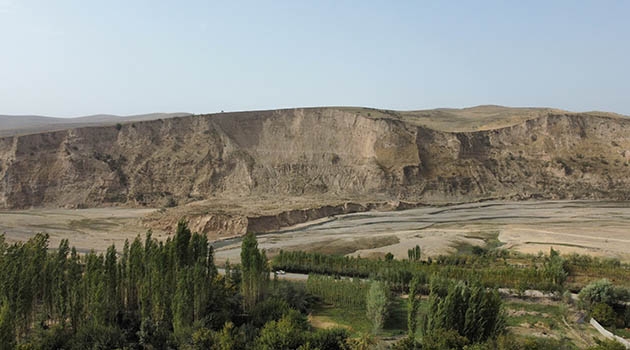Quest for Central Asia’s first hominins
Primitive stone tools made hundreds of millennia ago have been found on the windswept loess plateaux of Tajikistan. How old are they? What species of hominin created them? And how did past climate change affect scope for living here? An international research expedition is now seeking answers to these questions.
“We’ve been collecting sediment samples. Today, we have the methods and technology to find out how old an environment is. Tajikistan is a key area that can tell us how humans spread through Asia,” says Ramona Schneider, a PhD student at Uppsala University’s Department of Earth Sciences who joined the expedition.
It was probably through these very areas that early hominins migrated when Asia was being populated. They have left traces in the form of stone tools that vary from markedly simple to increasingly advanced designs. However, there seems to be no question of human presence having been continuous, probably owing to the climate. Nowadays, the area is semi-arid, but when the 100-metre-high, compacted loess soil layers were deposited it was colder, drier, dustier and considerably windier. This was because there was an ice age in the Northern Hemisphere at the time.
“That was a terribly hostile environment to live in,” says Thomas Stevens, Senior Lecturer at the Department of Earth Sciences and one of the project leaders.
But the inhospitable periods alternated with warmer, wetter climatic eras. This is visible in the form of dark bands, composed of organic material and clay minerals, that break up the light-coloured, tightly packed layers of loess soil here and there. The vegetation was more abundant at the time and humans were attracted to the region. But who they were is unknown; no skeletal remains have been found.
Primitive stone tools
The stone tools were found in sediment sequences dating back about a million years. The oldest tools were made with a simple technique used by several extinct hominin relatives of ours. Among them was Homo erectus, who lived between roughly 1,800,000 and 100,000 years ago. This was the human species that existed on Earth longest and also, as far as we know, the first to spread to Asia and Europe.
Sciences is one of the project leaders.
Photo: Malin Eivergård
But researchers do not yet know whether any of the tools in Tajikistan originated with Homo erectus. Later hominins, such as the Neanderthals and Denisovans – two species whose DNA has been mapped – may conceivably have invented some of these tools and lived there at the same time as modern humans. How the site was populated and by whom are questions the researchers are now attempting to answer.
“Part of the project in Norway is about finding biochemical techniques to locate traces of human faeces in the sediments and try to extract DNA from it. But hopes of finding DNA aren’t particularly high,” Stevens says.
Magnetic signals in minerals
Scientists on the expedition have brought home soil samples from both the dark and the light sequences. These are now to be dated in Denmark, using several methods. One task is to examine magnetic signals in minerals. These can reveal how long the loess soil has been present at the site. This is because Earth’s magnetic poles are not static: they move and can even change places. When sediment is deposited, minerals that are magnetic rotate in the direction of the North Pole, thus creating a snapshot of what Earth's magnetic field looked like at the time.
the compacted loess soil.
Photo: Olya Meshcheryakova.
It is not only the age of the soil samples that interests the researchers. They also want to know how, in the past few centuries, the climate has varied in the region. Stevens and Schneider hope to be able to reconstruct how many millimetres of precipitation fell every year. To get an idea of the shifting temperatures, they will analyse interrelationships among carbon and oxygen isotopes, which vary depending on whether the climate has been warm or cold.
Åsa Malmberg

